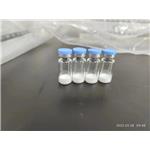Usage And Synthesis
The KISS1 gene and its product KISS1 were identified to be a natural ligand for an orphan receptor, GPR54, in humans in 2001. In addition to Kiss1, the existence of a highly homologous peptide was reported when the first kiss1 gene in a nonmammalian species was found. Subsequent synteny analysis as well as reporter assays strongly suggested that: (1) both peptides are kisspeptins in terms of being ligands of GPR54; (2) kiss1 and kiss2 genes3 are suggested to have been duplicated in the early vertebrate lineage; and (3) both are conserved in the majority of vertebrates, although placental mammals and marsupials lack Kiss2.
Although longer forms have been isolated, the 10 aa residues with the amidated C-terminal have been shown to activate the kisspeptin receptor Gpr54 signaling pathways. For instance, human prepro-kisspeptin consists of 145 aa residues and is cleaved to a shorter C-terminus that varies from 10 to 54 residues. The C-terminal RF/RY-NH2 is the most conserved motif within the RFamide peptide family to which kisspeptins belong.4 Native Kiss1/2 peptides have been isolated from tissues in a very limited number of species.
Target cells/tissues and functions
In mammals, accumulating evidence strongly suggests that Kiss1, which is produced in hypothalamic Kiss1 neurons, directly and indirectly activates GnRH1 neuron firing activity, and eventually the HPG axis. Given that mutations of the kisspeptin ligand or receptors lead to infertility, the kisspeptin system is believed to be essential for the regulation of reproduction in placental mammals. On the other hand, there is no clear evidence for kisspeptin regulation on reproduction in nonmammalian vertebrates. In addition to the regulation of reproductive functions, kisspeptin is suggested to be involved in various other functions. Some of the candidate action sites outside the HPG axis include neurons producing oxytocin, prolactin (mammals), vasotocin, isotocin,8 and somatostatin (teleosts).
In mammals, accumulating evidence strongly suggests that Kiss1, which is produced in hypothalamic Kiss1 neurons, directly and indirectly activates GnRH1 neuron firing activity, and eventually the HPG axis. Given that mutations of the kisspeptin ligand or receptors lead to infertility, the kisspeptin system is believed to be essential for the regulation of reproduction in placental mammals. On the other hand, there is no clear evidence for kisspeptin regulation on reproduction in nonmammalian vertebrates. In addition to the regulation of reproductive functions, kisspeptin is suggested to be involved in various other functions. Some of the candidate action sites outside the HPG axis include neurons producing oxytocin, prolactin (mammals), vasotocin, isotocin,8 and somatostatin (teleosts).
In both teleosts and mammals, it has been demonstrated that some kisspeptin neurons show high steroid sensitivity in that they alter their expression in accordance with serum sex steroid concentration. This suggests that the cis-regulatory elements of the kisspeptin gene include estrogen-responsive elements, and the presence of some transcription factors in a certain kisspeptin neuronal population determines whether positive or negative expressional regulation of kisspeptin genes occurs. Thus, kisspeptin neurons are sensitive to gonadal/breeding states, and their steroid-sensitivity of expression/ release is widely conserved in vertebrates, at least in Osteichthyes. Recently, it was suggested that in the mouse, Kiss1 neurons in the arcuate nucleus coexpress neurokinin B and dynorphin to enhance/suppress their firing activities, respectively, in autocrine/paracrine manners. Some physiological evidence further suggests a hypothesis that their interactions may underlie the pulsatile release of GnRH/LH in mammals.
Kisspeptin receptor Gpr54 is a G protein-coupled receptor. As is true with the ligands, Gpr54 also has paralogs, Gpr54-1 and -2, in vertebrates. Reporter assay studies have shown that both Kiss1 and Kiss2 activate both the Gpr54-1 and -2 signaling pathways. However, dose-dependence analysis shows that Kiss1 prefers Gpr54-1 and Kiss2 prefers Gpr54-2 in many species
Kisspeptin is a neuropeptide that is encoded by the kiss1/ kiss2 gene in vertebrates. Kisspeptin neurons are mainly localized in the hypothalamus, and there is a growing body of evidence to support their essentiality and importance for reproduction in mammals.
Kisspeptin, which is found in chocolate, is the hormone in the brain which kickstarts puberty.
Mutation of the KISS1 gene or neurokinin B (TAC3) gene (an autocrine/paracrine neurotransmitter of arcuate kisspeptin neuron activities) causes idiopathic hypogonadotropic hypogonadism. GnRH application to patients with this disorder resulted in the partial recovery of their fertility, similar to cases in rodent and primate studies.
It has been suggested that Kisspeptin may mediate effects on several cell types with the HPG axis. In vitro studies have shown that Kisspeptin can mediate vasoconstriction and inhibit angiogenesis, and it has been reported that Kisspeptin stimulates glucose-induced insulin secretion in animal studies. However, Kisspeptin was well tolerated, with no side effects or adverse events reported. In addition, Kisspeptin had no significant clinical effects on blood pressure or heart rate[1-2].
[1] Edouard G Mills. “Effects of Kisspeptin on Sexual Brain Processing and Penile Tumescence in Men With Hypoactive Sexual Desire Disorder: A Randomized Clinical Trial.” JAMA Network Open 6 2 (2023): e2254313.
[2] Calley, J. and W. Dhillo. “Effects of the Hormone Kisspeptin on Reproductive Hormone Release in Humans.” 2014. 0.
[2] Calley, J. and W. Dhillo. “Effects of the Hormone Kisspeptin on Reproductive Hormone Release in Humans.” 2014. 0.
Kisspeptin Supplier
Tel +86-19948166995 +86-19948166995
Email sale01@hbweimiao.com
Tel +86-17531957005; +undefined17531957005
Email xunou8@hbxunou.com
Tel +8615373025980
Email clara@hbshengyang.com
PROMPT×
PROMPT
The What'sApp is temporarily not supported in mainland China
The What'sApp is temporarily not supported in mainland China
Cancel
Determine

